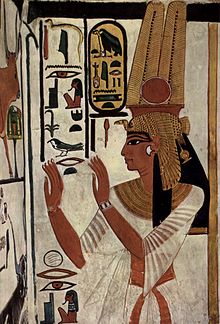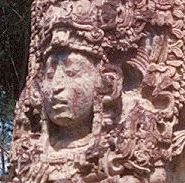Headdress

A headdress or outdated and headdress or head Zierrath is an ornamental headgear that does not serve primarily the purpose of Bekleidens or for the protection of the head, but the decoration or the highlighting of oneself.
Different designs
Headdresses include, for example, the ancient Egyptian vulture bonnet , the tiara , the diadem , the crowns of Western rulers, the pearl-string beret of the Chinese emperors and the gold bonnet or ribbon bonnet in traditional Eastern Bavarian and Austrian costumes. Likewise, the headdress count the feathered decorated Indian Warbonnet , African bonnets or hair ornaments with beads. According to the theater lexicon of 1841, the term headdress applies in particular to female head decorations, which can include pearls or diamonds in addition to clasps, ribbons, feathers.
The headdress plays a special role in traditional costumes , where it often contributes significantly to the differentiation from other, similar costumes and to the identification of a certain costume, as well - and often even more - but also to research the historical development of a costume, whatever is closely related to the history of settlement and population shifts in an area .
In earlier times there was the profession of "plasterer" for the manufacturers of this decoration. The official job title is milliner .
In Great Britain in particular , the headdress has a special meaning for the clothing of women at official festivities such as weddings and important horse races. He is called a fascinator .
Headdress as a symbol of status
In addition to clothing, the traditional headdress served in particular as a visible symbol of a stand. For example, the Germanic leaders wore a headdress (also in the form of braided wreaths of hair) as a sign of their dignity and power to show everyone their position. Since only a few people could read, these symbols were an important distinguishing feature. Uniform headgear can also be found in many professions. They are not used as jewelry, but as identifying features (hood of the nurse or maid, beret or helmet of the soldier, spiked hood or service cap of the police officer). In warm countries like Africa, where tribal affiliation or marital status is not expressed through clothing, this can be read from the headdress. For example with Ethiopian women. In Europe, too, the marital status of married women was indicated by wearing a hood ( giver ) in the Middle Ages . At the wedding, many brides also wear a bridal veil as a headdress, which partially or completely covers the face.

Headdress as a symbol of power
Even thousands of years ago, the emperors, kings and princes of antiquity adorned themselves with special hats or wreaths. Whereby the ruling class usually had a particularly splendid headdress, for example for representation purposes. These include the heavy golden crowns that were not intended to be worn permanently. Examples of this can be found in many cultures, especially in advanced civilizations, for example in Egypt (vulture hood, Nemes headscarf , different crowns), in the Orient ( turban of an emir , caliph , sultan or maharajah ) or among the Maya and Aztecs ( feather crown of Moctezumas ). In other cultures it was more of a simple wreath that served as a headdress and was supposed to protect its wearer or to give it special powers. These can be found, for example, with the Sumerians or Etruscans . Wreaths as decorations are also known from ancient Greece ( Stephanos ) or the Roman Empire ( laurel wreath ), where, for example, as wreaths they pointed to the special meaning or achievement of the wearer.
literature
- Mario Schmidt: needles as headdresses in the late Hallstatt period. (= University research on prehistoric archeology. 242.) Rudolf Habelt, Bonn 2013, ISBN 978-3-774-93836-6 .
Web links
- Apprenticeship as a milliner at bibb.de
- History of the gold bonnet on goldhauben.info
Individual evidence
- ^ A b Philipp Jakob Düringer , Heinrich Ludwig Barthels: Theater-Lexikon. Theoretical-practical manual for board members, members and friends of the German theater. O. Wigand, Leipzig 1841, OCLC 6838332 , pp. 633/634. ( online )
- ↑ a b Crowns - symbols of power. from planet-wissen.de, accessed on May 19, 2014.
- ↑ Pickelhaube - symbol for Prussian militarism. in: The world. dated February 15, 2011, accessed May 19, 2014.
- ↑ African Hairstyle - Colorful hair traditions of the Mumuilas on touring-afrika.de, accessed on May 19, 2014.
- ↑ Rolf Ballof (ed.): History of the Middle Ages for our time. Steiner, Stuttgart 2003, ISBN 3-515-08224-7 , p. 189. ( online ).
- ↑ Crowns of the Gods and Pharaohs on Leben-in-luxor.de, accessed on May 19, 2014.
